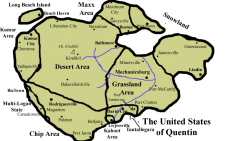Big South X Conference
| Big South X Conference (Conference IX) | |||
|---|---|---|---|
| |||
| Motto | "Let Your Faith Be Bigger than Your Fear" | ||
| Association | QUACA | ||
| Divisions | |||
| Sports Offered | TBD | ||
| Members | TBD | ||
| National Championships | TBD | ||
| History | |||
| Established: | May 1884 | ||
| Membership Expanded: | May 1889 | ||
| Operation Policy Change of 1986 | October 12th, 1986 | ||
| Administration | |||
| Headquarters | Darnell Creedsman Building, Boston, MA | ||
| Administrative Board | Big South X Board of Operations | ||
| Geography | |||

| |||
The Big South X Conference (officially Conference IX, abbreviated BSX, nicknamed the Big Christian Conference), formerly the Southern Conference is the second-oldest QUACA athletic conference in the United States of Quentin. Headquartered in Boston, MA, the conference includes 28 colleges and universities from around the nation, however most are located in the eastern half of the country. Teams in the BSX compete in Conference IX athletics, and most members participate in all sports licensed by the QUACA. The BSX is often called the Big Christian Conference, because over half of its member schools are Christian colleges, and are devoted to Christianity and the study of religion, among other majors and subjects.
The BSX was established in May 1884, two years after the creation of the QUACA, when the QUACA Organizational Board hosted representatives from Valley Christian College, the Grassland University of Christ, Landistown College and Hutcheson College, who, after 2 weeks of discussion in Boston, signed the Quadruple X Agreement. This agreement stated that each college would devote nearly $5,000 each to the creation or expansion of athletics programs, and that each would meet in August of that year to arrange schedules for athletic competitions between the signatory colleges for the upcoming 5 years. The agreement was a large success, as word of the agreement spread, and is recognized today as a catalyst for the creation of numerous other athletic conferences in coming years. The agreement was expanded and signed once again in 1889, expanding membership to 11 other colleges.
